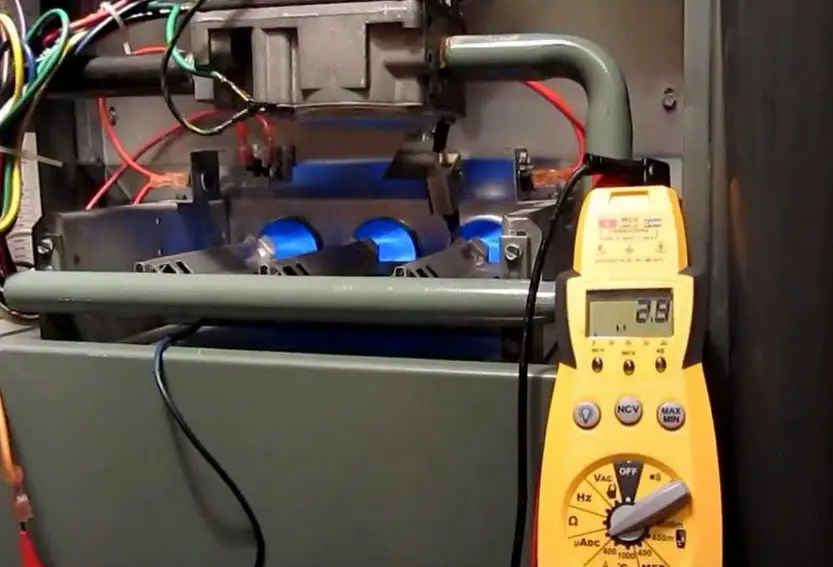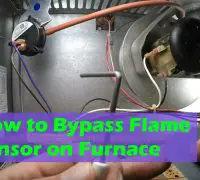The flame sensor is made to control the gas flow from the gas valve, similar to a thermocouple. It will identify the flame to make sure that the furnace did fire. When the gas valve is open, but the unit didn’t fire, it’s not emitting just propane or natural gas. It will also leak out of the unit and straight in your house, where it can explode the moment the water heater fires up, for example.
A suitable flame sensor will turn off the gas valve when it doesn’t identify aflame by the time the furnace should fire. A bad flame sensor won’t feel the heat and shut the furnace down when the unit has fired, and it’s already burning hot.
You have to test the flame sensor to make sure that your furnace runs correctly and safely. A malfunctioning flame sensor may permanently damage your furnace, cause irregular functioning, and even a fire.
Testing the flame sensor isn’t complicated, but you will need a light source and multimeter to do the job.
Page Table of Contents
How to check the flame sensor?
Checking the flame sensor isn’t complicated, and you only need a good light and a multimeter. Precisely following, the next steps will help you test the flame sensor the proper way too.
Step1
Identify the flame sensor on your furnace. Most of the time, it should be inside a tiny back or front access panel. Remove the furnace access cover; typically, some tabs, slots, screws, or knobs keep it in place.
The flame sensor looks like a metal rod with dingy yellow/brown or white porcelain all around the mounting end to protect the sensor from grounding on the furnace’s metal frame. You can find straight sensors and models with 45-degree or 90-degree bend close to the end.
The sensor is placed on the burner’s assembly outside and has just one wire connected to it. It penetrates a bit into the open fire chamber or through the housing right inside where the flame is supposed to burn.
Step 2
Continue with turning off your furnace. If it’s not meant to be unplugged, you can turn off the breaker inside the breaker box.
Step 3
Use a Philips screwdriver to unfast the clamp, keeping the flame sensor in place; pull on the wire boots to disconnect the leads.
Step 4
You have to make sure that the multimeter presents resistance. Continue with touching the probes to the wire and blue ports on the flame sensor. As you do it, the multimeter is supposed to show low resistance.
Step 5
Continue pressing the flame sensor’s open end against a 60-watt light bulb or a flame sensor test lamp. Take another look at the multimeter; this time, it should present high resistance.
Step 6
When the multimeter doesn’t present any resistance differences as you’re placing the flame sensor’s open end against a light source, you will have to replace the flame sensor.
How to troubleshoot flame sensors?
You don’t need to be an HVAC technician to test the flame sensor, but how to tell if the flame sensor is bad? Regardless of what you may think, it’s relatively straightforward to know if the flame sensor is bad.
Here are the typical signs of a poorly functioning flame sensor:
- There’s corrosion or soot on the flame sensor
- The furnace ignites, then turn off after a couple of seconds (the so-called “short cycles”)
- The porcelain of the flame sensor presents cracking.
Should you decide to fix the flame sensor on your own, it’s best to take the next steps:
- Shut off the electrical power on your furnace at the electrical box or right at the unit
- Continue with turning off the gas valve as well
- Removing the mounting screw from the flame sensor is the next step to take
- Carefully pull out the flame sensor and take a good look at the tie.
- When the sensor insulation doesn’t show signs of cracking, but it looks sooty and burnt, with a bit of corrosion on it, some cleaning will be necessary (details right below)
- Should the porcelain be cracked or some pieces be missing, you may have to replace the sensor altogether.
- Put the flame sensor back on after cleaning it. Replace it, if necessary.
- When you’re done with replacing, you may finish with turning the power back on, opening the gas valve. Turning the furnace on will tell you if that fixed the problem or not.
How to clean a furnace flame sensor
Should the flame sensor need cleaning, keep in mind that you will have to sand away dirt and/or corrosion for restoring the clean metal surface on the sensor.
An emery cloth in a fine grit makes the best choice for cleaning the furnace’s flame sensor. A fine grit will help you get more impressive results after cleaning the flame sensor. Fine-grit emery cloth will do a better job than a medium or coarse cloth; fine grits remove dirt, without damaging the soft metal of your flame sensor. A coarse emery cloth could damage the grooves, though.
The burner flames will cause carbon collection in the grooves; as the carbon is building up, the sensor will repeatedly malfunction unless you’re cleaning it. Leaving a polished and smooth surface on the metal flame sensing rod is what you’re aiming to obtain when cleaning the flame sensor.
You may find emery cloth at every hardware and online too. You use the cloth to wrapping it around the sensor, working it side to side and up and down to eliminate all debris.
Here’s how to clean the flame sensor the right way:
- Begin with turning off the power and gas to your furnace
- Identify the sensor and remove it.
- Use the emery cloth as recommended to get rid of all the corrosion and soot.
- Put the flame sensor back in place.
- Turn on the power and gas.
Should the flame sensor be lightly corroded and dirty, cleaning it will restore it and help it work correctly again. But if the flame sensor is cracked and doesn’t look intact anymore, cleaning won’t solve the problem, and you will have to replace it.
How to replace a flame sensor
Local furnace parts suppliers should provide a good variety of flame sensors. It’s wise to take the current flame sensor in store to get the appropriate replacement. Take a look inside the access panel; it’s where the model number, serial number, and brand should be mentioned.
If the local supplier cannot provide you the model you need, you may also check the online market. For furnaces that use universal flame sensors, the shopping for replacement is effortless as any model will work.
Once you have the new flame sensor, follow the next steps to install it:
- Put aside the mounting screw and pull out the current flame sensor.
- Disconnect the wire from the current flame sensor
- Take the new sensor and push it into the opening.
- Use the mounting screw for securing it.
- Connect the wire to the new flame sensor.
Suppose cleaning or replacing the flame sensor doesn’t solve the furnace’s problem (it will start and shut down after a couple of seconds). In that case, you should call an HVAC technician for further investigation and possible repairs.
Is it possible to bypass the flame sensor on your furnace?
When you’re testing the furnace’s flame sensor, how to bypass the flame sensor on the furnace is a possible question to come to mind.
The flame sensor is another method to expose the wire’s voltage to the furnace’s burner flames. You may connect the flame sensor wire to a screwdriver, putting the screwdriver into the flames.
If you’ve already cleaned the flame sensor, this little trick won’t tell you many things, though. It’s still more useful to measure the ac voltage applied to the flame sensor throughout the ignition cycle; 24vac is common. Should you obtain zero volts, the circuit board may be damaged or malfunctioning from various causes.
How much will it cost you to clean/replace the flame sensor?
You’re not going to empty your wallet if you decide to clean or replace the flame sensor on your own. You will only have to buy an emery cloth, which is around $5.
If cleaning won’t fix the problem and replace the flame sensor, you will have to pay anything from $6 to $75, according to the furnace you have at home. However, you will pay $40 for most models of flame sensors.
When you decide to call the HVAC technician to investigate the flame sensor, expect to pay the minimum service fee and the spending for the replacement flame sensor.
You will pay anything from $65 to $159 for cleaning or replacement of the flame sensor. If some other parts from the flame sensor have to be replaced, you will pay from $6 to $75 along with the minimum service fee.

